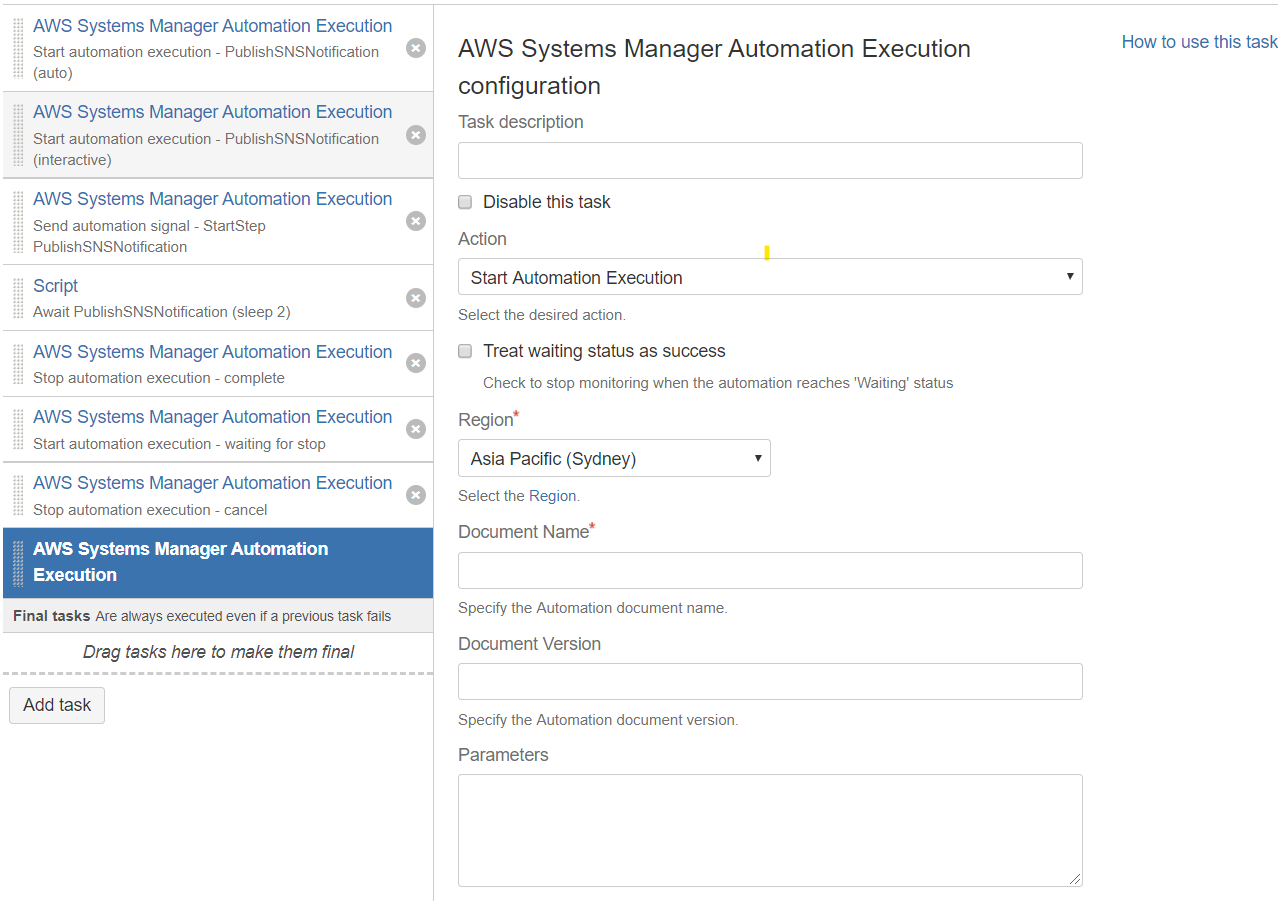Configuration
To configure an AWS Systems Manager Automation Execution task:
Navigate to the Tasks configuration tab for the job (this will be the default job if creating a new plan).
Click the name of an existing AWS Systems Manager Automation Execution task, or click Add Task and then AWS Systems Manager Automation Execution to create a new task.
Complete the following settings:
Common to all tasks
Actions supported by this task:
Start Automation Execution | |
|---|---|
| Treat waiting status as success | Check to stop monitoring when the automation reaches 'Waiting' status |
| Document Name | Specify the Automation document name. |
| Document Version | (Optional) Specify the Automation document version. |
| Parameters | (Optional) Specify the execution parameters, which match the declared parameters in the Automation document. (JSON – inline or via URL) – refer to Parameters for details. |
| Target Definition Type | |
| Target Maps | (Optional) Specify the key-value mapping of document parameters to target resources. (JSON – inline or via URL) – refer to About Targets and Target Maps for details. |
| Target Parameter Name | (Optional) Specify the name of the parameter used as the target resource for the rate-controlled execution |
| Targets | (Optional) Specify the key-value mapping to target resources. (JSON – inline or via URL) – refer to About Targets and Targets for details. |
| Target Locations | (Optional) Specify the combination of AWS Regions and/or AWS accounts where you want to execute the Automation. (JSON – inline or via URL) – refer to Running Automation Workflows in Multiple AWS Regions and Accounts and Target Locations for details. |
| Max Concurrency | (Optional) Specify the maximum number of targets allowed to run this task in parallel (integer or percent) |
| Max Errors | (Optional) Specify the number of errors that are allowed before the system stops running the automation on additional targets (integer or percent) |
| Advanced Options | Specify the combination of AWS Regions and/or AWS accounts where you want to execute the Automation. (JSON – inline or via URL). |
| Mode | Select the execution mode of the automation. |
| Await Desired Status Timeout | Specify how long to await the automation execution reaching the desired status (seconds, 0 to skip). |
Send Automation Signal | |
| Automation Execution ID | Specify the execution ID of the Automation to signal. |
| Signal Type | Select the type of signal. |
| Signal Payload | (Optional) Specify the data sent with the signal. (JSON – inline or via URL) – refer to Payload for details |
Stop Automation Execution | |
| Automation Execution ID | see Send Automation Signal above |
| Type | Select the stop request type. |
Variables
All tasks support Bamboo Variable Substitution/Definition - this task's actions generate variables as follows:
Start Automation Execution
Creating common variables for 1 resources affected by task: ... bamboo.custom.aws.systemsmanager.parameter.resources: /taws-it280/4/ubot Creating resource variables for parameter '/taws-it280/4/ubot': ... bamboo.custom.aws.systemsmanager.parameter.resources./taws-it280/4/ubot.Name: /taws-it280/4/ubot ... bamboo.custom.aws.systemsmanager.parameter.resources./taws-it280/4/ubot.Version: 1 Creating common variables for first resource affected by task: Creating resource variables for parameter '/taws-it280/4/ubot': ... bamboo.custom.aws.systemsmanager.parameter.first.Name: /taws-it280/4/ubot ... bamboo.custom.aws.systemsmanager.parameter.first.Version: 1
Send Automation Signal
Creating common variables for 1 resources affected by task: ... bamboo.custom.aws.systemsmanager.parameter.resources: /taws-it280/4/ubot Creating resource variables for parameter '/taws-it280/4/ubot': ... bamboo.custom.aws.systemsmanager.parameter.resources./taws-it280/4/ubot.ARN: arn:aws:ssm:us-east-1:288727192237:parameter/taws-it280/4/ubot ... bamboo.custom.aws.systemsmanager.parameter.resources./taws-it280/4/ubot.Name: /taws-it280/4/ubot ... bamboo.custom.aws.systemsmanager.parameter.resources./taws-it280/4/ubot.Selector: null ... bamboo.custom.aws.systemsmanager.parameter.resources./taws-it280/4/ubot.SourceResult: null ... bamboo.custom.aws.systemsmanager.parameter.resources./taws-it280/4/ubot.Type: String ... bamboo.custom.aws.systemsmanager.parameter.resources./taws-it280/4/ubot.Value: taws-it280-4-ubot-2 ... bamboo.custom.aws.systemsmanager.parameter.resources./taws-it280/4/ubot.Version: 2 ... bamboo.custom.aws.systemsmanager.parameter.resources./taws-it280/4/ubot.LastModifiedDate: 20180912T125434Z Creating common variables for first resource affected by task: Creating resource variables for parameter '/taws-it280/4/ubot': ... bamboo.custom.aws.systemsmanager.parameter.first.ARN: arn:aws:ssm:us-east-1:288727192237:parameter/taws-it280/4/ubot ... bamboo.custom.aws.systemsmanager.parameter.first.Name: /taws-it280/4/ubot ... bamboo.custom.aws.systemsmanager.parameter.first.Selector: null ... bamboo.custom.aws.systemsmanager.parameter.first.SourceResult: null ... bamboo.custom.aws.systemsmanager.parameter.first.Type: String ... bamboo.custom.aws.systemsmanager.parameter.first.Value: taws-it280-4-ubot-2 ... bamboo.custom.aws.systemsmanager.parameter.first.Version: 2 ... bamboo.custom.aws.systemsmanager.parameter.first.LastModifiedDate: 20180912T125434Z
Stop Automation Execution
N/A
How-to Articles
Frequently Asked Questions (FAQ)
Atlassian account required
